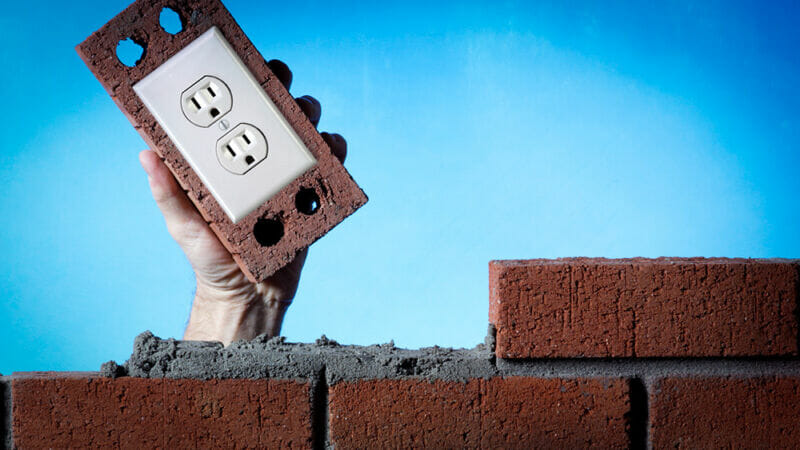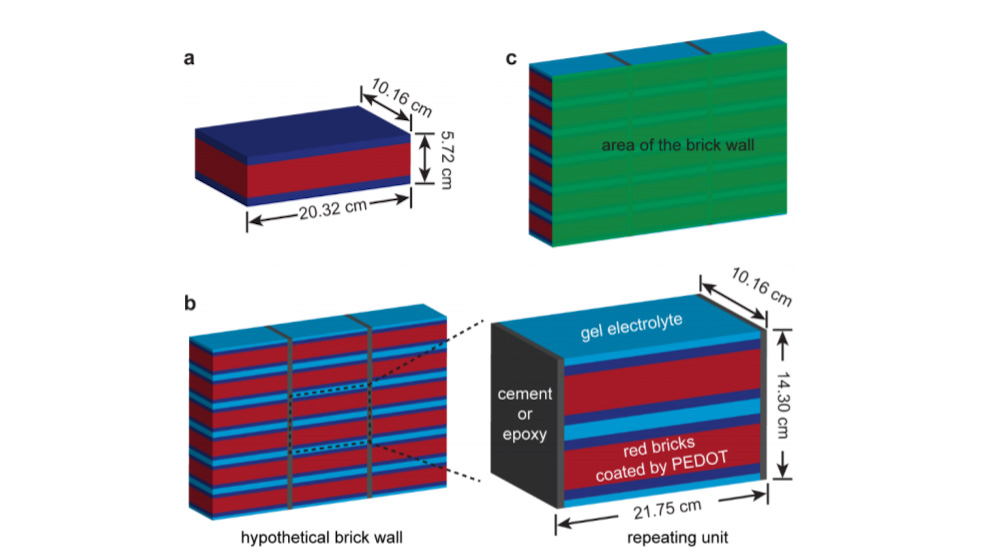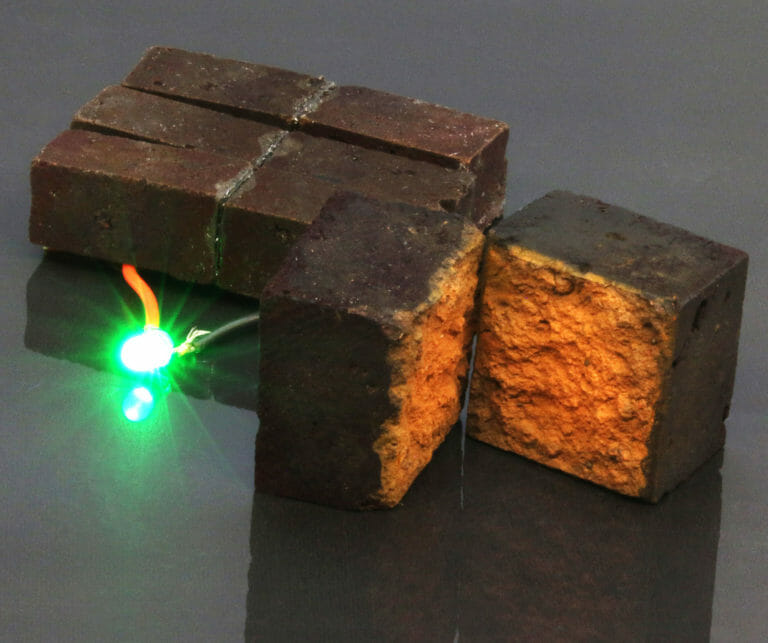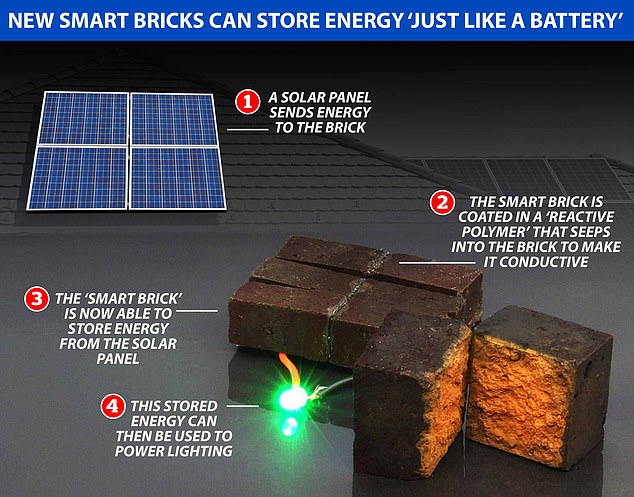Bricks; simple substance and building block of elementary constructions. From past thousands of years, this block has been utilized for the construction and rarely thought to be of any other use. After using once to build something, it becomes strong and powerful and can never be used again for any other purpose. Unimaginably, now this fundamental unit of construction is revolutionised by the chemists of Washington University in an incredible manner. They have made amazing Energy storing bricks that could be best solution of all our power storage needs.
Before getting further to fancy things about the newest technology, lets know what is the basic idea of it.
Basics of Energy Storing Brick:
Red brick, which is mostly made under fire and utilized throughout the history has played vital role in construction and real estate industry.
Developing and learning from the history, and combining it with modern technology can create incredible things.
–ANON
Chemists have done the exact, and have made ‘smart bricks’, that can store energy. Energy in them can be stored until it is utilized from it and used for energizing the power requirements of electronic devices.
A simple brick is made from mixture of different compounds like
- Silica (sand)
- Alumina (clay)
- Lime
- Iron oxide
- Magnesia
All in different proportions, as per the needs.

Many architects have accepted that common bricks have a property of capturing and storing the Sun’s heat in a great way. Also, walls and buildings made out of bricks and cement occupy large amount of space and is underutilized in a way. So, chemists thought that why not give them an energy storage purpose in addition to just occupying space.
Implementing this next level thought was bit challenging, yet researchers at Washington university managed a way to get it done. They converted simple red brick into an energy storing brick called a supercapacitor.
Getting Deeper Understanding in a simple way:
The red colour of the usual bricks is due to presence of hematite, which is ore of iron. Interestingly, state-of-the-art energy storage devices and batteries are also made from the same hematite ore. This triggered the thought of combining one with another. Using polymer technology and microstructures present in the conventional bricks, chemists have done the transformation.
They developed a supercapacitor, using common brick’s hematite microstructure as reactant. Then they deposited a fine layer (technically termed as nanofibrillar) of conducting polymer.
Polymer was PEDOT- poly (3,4 ethylene-dioxy-thiophene). Click here to see the structure of polymer.
This leads to coatings offering high electrical conductivity and easy charge transfer. This makes them to use as ideal electrodes for the technology.
Also, these devices are made water resistant by applying epoxy coating encapsulating the structure. This even makes them to store the charge carriers from temperatures between -20oC to 60oC.

Simply, in the figure a.
Red brick is dissolved in the vapour of HCl acid at 160oC high temperature. As red bricks contain hematite and it is ore of iron (Fe), this dissolution liberates Fe3+ ion. This promotes hydrolysis with water, and forms FeOOH nuclei. These nuclei are the reason which initiates and controls the polymerization reaction. Finally, EDOT, which is monomer of PEDOT initiates to polymerize. With different reaction conditions, the thickness of polymer coating can be varied accordingly.
In figure b.
Generation of two different types of bricks is shown. One is surface polymerized, which is sort of partially polymerized. And another is fully polymerized monolithic PEDOT bricks.
Figure c.
Simply depicts that how concentration of the acid which is used can vary the length of the complete polymer. It shows that using high concentration of acid promotes the quality of final polymer that is formed.
These bricks, when connected in series connection coated with epoxy, produce a stable stationary waterproof supercapacitor module. Also, this brick provides excellent structural stability and open microstructure (as mentioned earlier) results in robust PEDOT-coated brick electrode.
Thus, coating of PEDOT polymer done by cutting the brick with diamond saw, provides better conducting abilities. This is comprised of nanofibers that penetrate the inner porous network of a brick. Ultimately, this polymer coating remains trapped in the brick and serves as an ion sponge which stores and conducts electricity.
Merits and future of energy storing bricks:
With increasing needs of power and electrical energy requirements, this technology can be a boom. As mentioned earlier, the epoxy coating applied on to the bricks enables the underwater usage of bricks possible when submerged in the water.

Scientists proposed this hypothetical brick wall to demonstrate usage and efficiency of the technology.
Figure a.
Wall has each brick of 8 inches × 4 inches × 2.25 inches and two faces of them covered with nanofibrillar PEDOT coat. In the above figure, red colour represents brick and blue shows PEDOT.
Figure b.
These bricks are then joined to form wall using 1.43 cm. gel electrolyte (light blue coloured) and 1.43 cm. epoxy coat (grey coloured).
Figure c.
Front wall area is shown green and calculations provided by researchers shows that this wall can provide maximum capacitance of 11.5 kF m-2 and energy density of 1.61 Wh m-2.
Gel electrolyte used while fabricating the PEDOT- coatings on the bricks, extends the cycling ability to 10,000 cycles and provides nearly 90% capacitance retention and almost 100% coulombic efficiency. This much high percentage of retention simply means that energy storing bricks are very efficient while using and proves to be great power storage and supply devices.
Talking about efficiency and electrical supply, these supercapacitor brick modules can provide a 3.6 V voltage window while three of them are connected in series connection.
With synthesis of PEDOT polymer via special polymerization technique called oxidative radical polymerization, properties like low electrical resistance as well as high chemical and physical properties can be achieved.
Looking to the above image, interestingly, it is now possible to connect bricks with solar cells and provide emergency lighting. Typically, connecting 50 bricks in close proximity to the load, can enable emergency lighting for 5 hours. Also, with changing and advancing solar cell technology, these methods can also be further modified.
Thus, with these energy storing bricks, chemists have redefined the ways of power storage. These could be the potential ideal building blocks for each of the constructions around the world and can change the future of building technology. They also believed that apart from making new bricks, it is also possible to manufacture them from recycled bricks, providing it a sustainable future.
indeed,
sometimes getting better with and from basics of our building blocks, can change the whole scenario of our own blissful future.
–OSD





Hi all, here every person is sharing these kinds of knowledge, so it’s good to read this weblog, and I used
to go to see this weblog all the time.
This is a topic which is close to my heart…
Best wishes! Exactly where are your contact details though?
[…] how these Energy Storing Bricks will replace even the batteries in near future for energy storage. Click Here to […]
Nice and neatly written.
Thanks a lot 😊